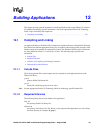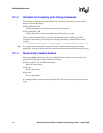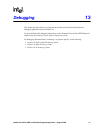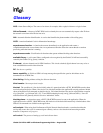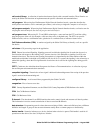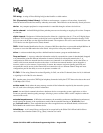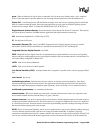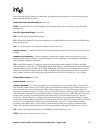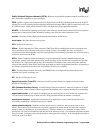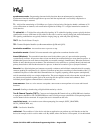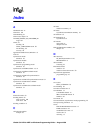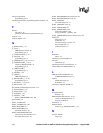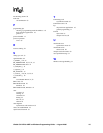
Global Call API for HMP on Windows Programming Guide — August 2006 149
synchronous mode: Programming characterized by functions that run uninterrupted to completion.
Synchronous functions block an application or process until the required task is successfully completed or a
failed/error message is returned.
T1: A digital line transmitting at 1.544 Mbps over 2 pairs of twisted wires. Designed to handle a minimum of 24
voice conversations or channels, each conversation digitized at 64 Kbps. T1 is a digital transmission standard in
North America.
T1 robbed bit: A T1 digital line using robbed bit signaling. In T1 robbed bit signaling systems, typically the least
significant bit in every sixth frame of each of the 24 time slots is used for carrying dialing and control information.
The signaling combinations are typically limited to ringing, hang up, wink and pulse digit dialing.
TBCT: See Two B Channel Transfer.
TEI: Terminal Endpoint Identifier (see Recommendations Q.920 and Q.921).
termination condition: An event that causes a process to stop.
termination events: Global Call events returned to the application to terminate function calls.
thread (Windows): The executable instructions stored in the address space of a process that the operating
system actually executes. All processes have at least one thread, but no thread belongs to more than one process. A
multithreaded process has more than one thread that are executed seemingly simultaneously. When the last thread
finishes its task, then the process terminates. The main thread is also referred to as a primary thread; both main and
primary thread refer to the first thread started in a process. A thread of execution is just a synonym for thread.
time slot: In a digital telephony environment, a normally continuous and individual communication (for example,
someone speaking on a telephone) is (1) digitized, (2) broken up into pieces consisting of a fixed number of bits, (3)
combined with pieces of other individual communications in a regularly repeating, timed sequence (multiplexed),
and (4) transmitted serially over a single telephone line. The process happens at such a fast rate that, once the pieces
are sorted out and put back together again at the receiving end, the speech is normal and continuous. Each
individual pieced-together communication is called a time slot.
tone resource: Same as a voice resource except that a tone resource cannot perform voice store and forward
functions.
transmit: Sending or broadcasting of digitized information by a device.
Two B Channel Transfer (TBCT): Connects two independent B Channel calls at an ISDN PRI user's interface
to each other at the PBX or CO. The ISDN PRI user sends a Facility message to the PBX or CO requesting that the
two B Channel calls be connected. If accepted, the user is released from the calls.
unsolicited event: An event that occurs without prompting (for example, GCEV_BLOCKED,
GCEV_UNBLOCKED, etc.).
USID: User Service Identifier.
unblocked: The condition of a line device such that an application can perform any valid function on the line
device, for example, wait for a call or make a call. By default, when a line device is first opened, it is in the blocked



